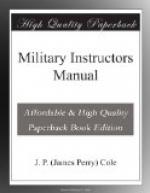Security:
Those measures taken to protect
a command from enemy observation,
annoyance and surprise.
Obtained by covering the front with
detachments.
March.—Advance, flank
and rear guards.
Camp.—Outposts.
March and camp detachments.—To
give warning and resist attack until
such time as detachment in rear can deploy.
Advance Guard:
Detachment from main body to cover
its advance.
Against surprise for information.
Push back small bodies.
Check enemy’s advance until
deployment in rear.
Seize good position and locate enemy
lines.
Remove obstacles.
Strength 1-20 to 1-3 of entire command.
Divisions of Advance Guard:
Cavalry point.
Infantry point.
Advance party.
Support.
Reserve.
Leading Troops:
A detachment protecting the head
of a column in retreat.
Rear Guard:
Detachments protecting the rear
of a retreating column.
Formation like that of advance guard.
Flank Patrols:
Detachments for protecting the flanks
of marching column.
March Outpost:
Detachments for protection of column
halted on march.
Formation, that of the marching
protection.
Outpost:
The detachments forming the protection
for a force in camp or
bivouac.
Divisions of Outpost:
Reserve.
Line of supports.
Line of outguards.
Pickets.
Sentinel Posts:
Sentry squads. Cossack posts.
Sentinels.
Detached posts (from support).
Hours of Special Danger:
Evening and dawn; thus good times
to relieve outposts.
Examining Post:
Intelligence and a place where prisoners,
etc., are brought in.
Orders:
The expression of the will of a
commander, either written or verbal.
Letters of instruction—plans
of the superior leaders.
Field Orders:
Regulate tactical and strategical
actions of troops.
General Orders Include:
(1) All necessary detailed instructions.
(2) All standing instructions (avoid
repetition).
(3) Proceedings of general and special
courts-martial.
Special Orders:
Relate to assignment and movement
of individuals, not necessary to
be communicated to the whole command.
Bearers of verbal orders must repeat.
Field Orders:
(1) Heading.—Title, place,
date, hour and number.
(2) Distribution of troops.—Division
of command.
(3) Body:
(a) Information
of enemy and supporting troops.
(b) General plan
of commander.
(c) Detailed tactical
dispositions to carry out general plan.
(d) Instructions
for trains—also the positions of ammunition
and
dressing stations.
(4) Ending.—Authentication
and method of sending.




